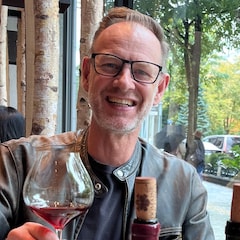Niigata Wine Coast: A Wine Region Built From Scratch
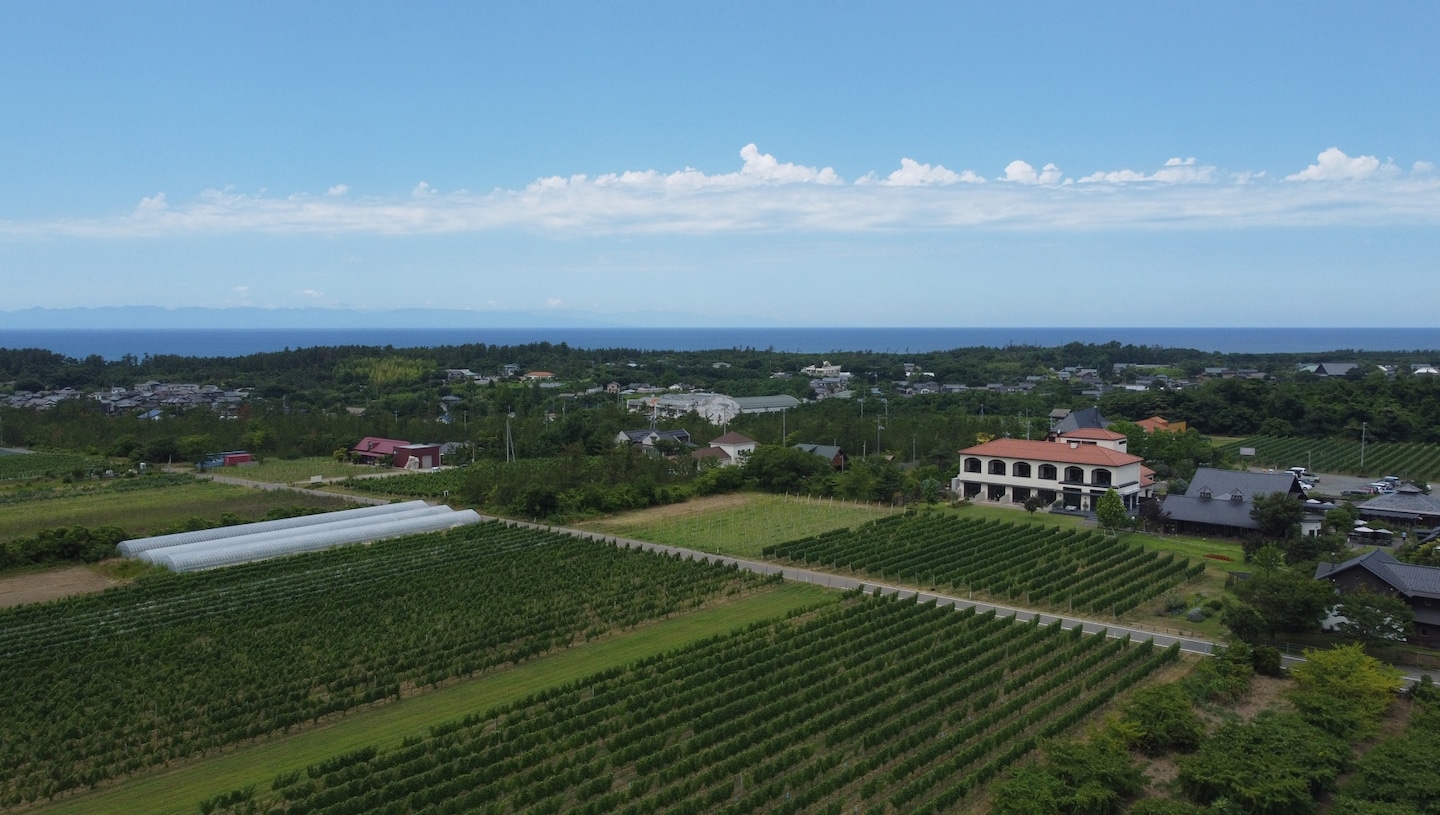
Vineyards in the Niigata Wine Coast by the Sea of Japan with Sado Island on the horizon. Photo: Andrew Lee
Inspired to taste wine made from Japan's oldest Albarino vines, Andrew Lee headed to the Niigata Wine Coast, where he discovered what may just be the most beautiful wine region in Japan, and is perfect for a weekend getaway.
By Andrew LeeFrom behind the tasting counter at Fermier winery on the Niigata Wine Coast, winemaker Takeshi Honda uncorks a bottle of his flagship “El Mar” Albariño and pours me a glass. As I take a sip of the pale gold liquid, its refreshing citrus, apricot, and peach aromas are followed by a crisp, clean acidity and the distinct briny edge that earns Albariño its nickname, “wine of the sea.” This is the wine I came for, made from grapes grown on the oldest Albariño vines in Japan, and it is truly excellent.
My introduction to Japanese Albariño had come a year earlier, at a wine tasting in Tokyo. It was from Cave D’Occi, Fermier’s neighbor, and I was floored by how good it was. I had no idea Albariño was even grown in Japan, but as a fan of the zingy whites from Rías Baixas—the Spanish region famous for the variety—I was impressed. I later learned that Cave D’Occi had pioneered the grape in Japan, but friends in the know all said the same thing: If you get the chance, you have to try Fermier’s. So here I am, working my way through a tasting flight, as Honda explains the difference between each cuvée.
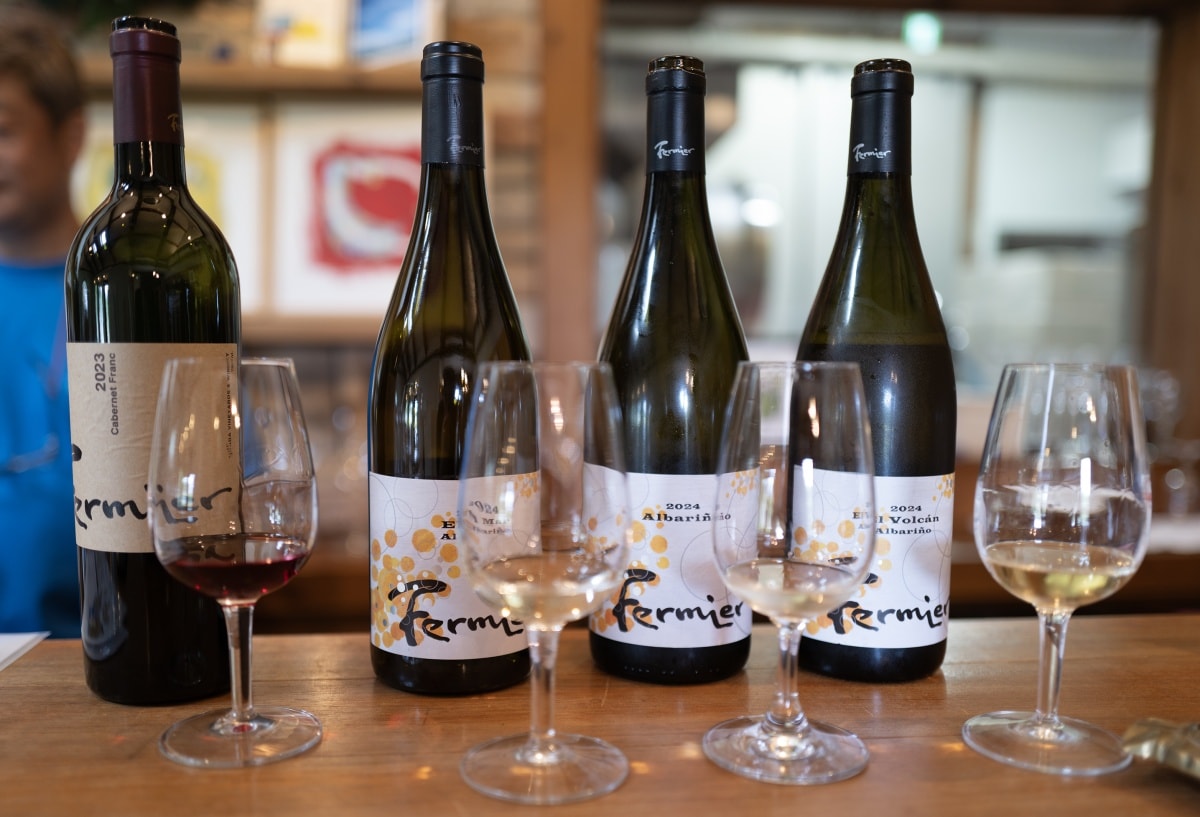
Worth the trip: A tasting flight at Fermier includes wine from the oldest Albariño vines in Japan. Photo: Andrew Lee
Earlier, as we weaved through the vineyard in his small truck, he pointed out Japan’s first Albariño vines—planted by Cave D’Occi in 2005, but now managed by him. He tells me they grow on deep sand layered over ancient volcanic rock from the picturesque Mount Kakuda nearby.
“Because the soil here is almost pure sand, it offers no nutrition and water drains quickly,” he says. This puts the vines under constant stress, which limits their vigor and leads to smaller yields with more concentrated fruit. For a variety like Albariño, which is naturally high-yielding, this restraint is a gift.
“The wines become very fine and delicate,” Honda says. They also develop the particular aromatics that Albariño from the Niigata Wine Coast is becoming known for.
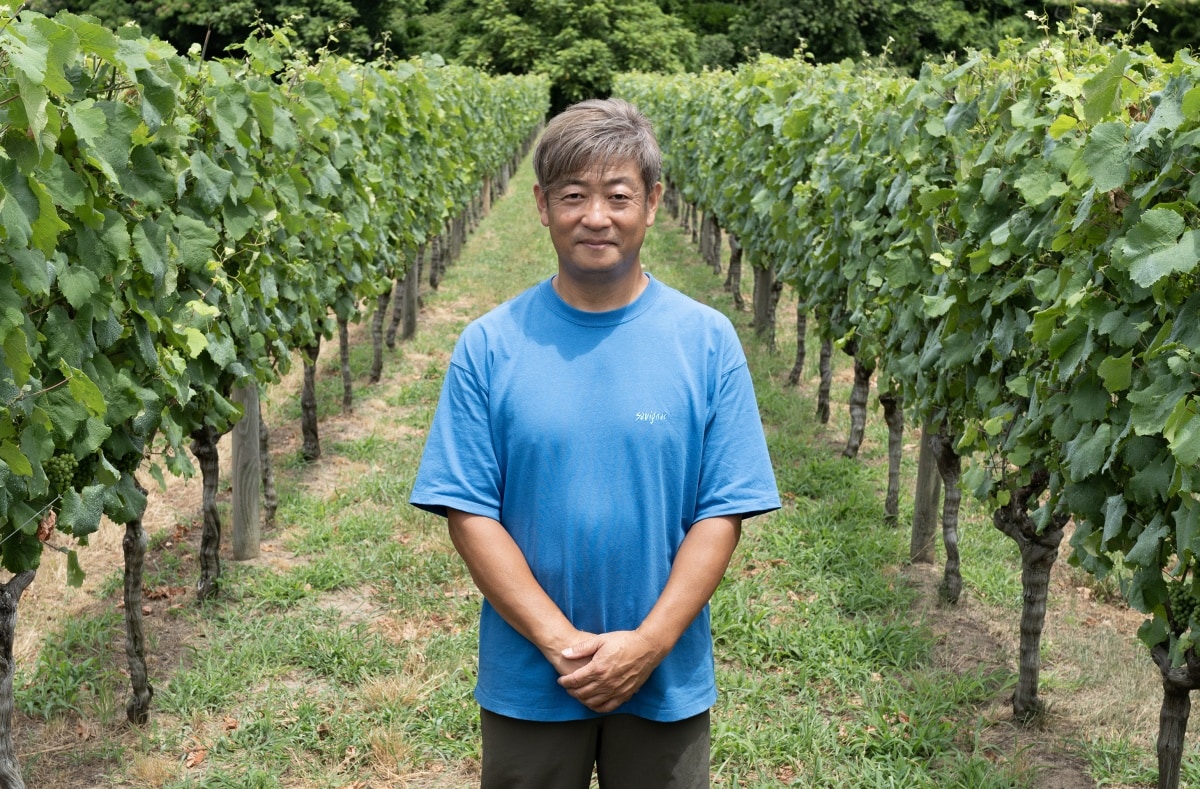
Winemaker Takeshi Honda stands among the oldest Albariño vines in Japan at Fermier winery in Niigata. Photo: Andrew Lee
Located beside the Sea of Japan, a 30-minute drive southwest of Niigata City, the “wine coast” is actually a cluster of five boutique wineries hidden among farmland on the western edge of the vast Echigo Plain. For centuries, this has been Japan’s largest rice-growing region. By the coast, however, the sandy soils of the alluvial plain combine with sea breezes that cool Niigata’s hot summer days to create conditions that are also ideal for viticulture—especially suited to Albariño.
The previous day, at Cave D’Occi, winemaker Fumito Kakegawa showed me around his vineyard and explained what makes the wine from here so unique. “The coast by the Sea of Japan has many sand dunes,” he says, grabbing a handful of soil and letting its grains pour through his fingers.
“When we grow Albariño on these dunes, for some reason we get a fragrance that nobody else seems able to produce—an oriental, Chinese-tea kind of aroma. In places without sandy soils, such as Yamagata, Toyama, or Kyushu, which also produce Albariño, you just don’t get those same aromas.”
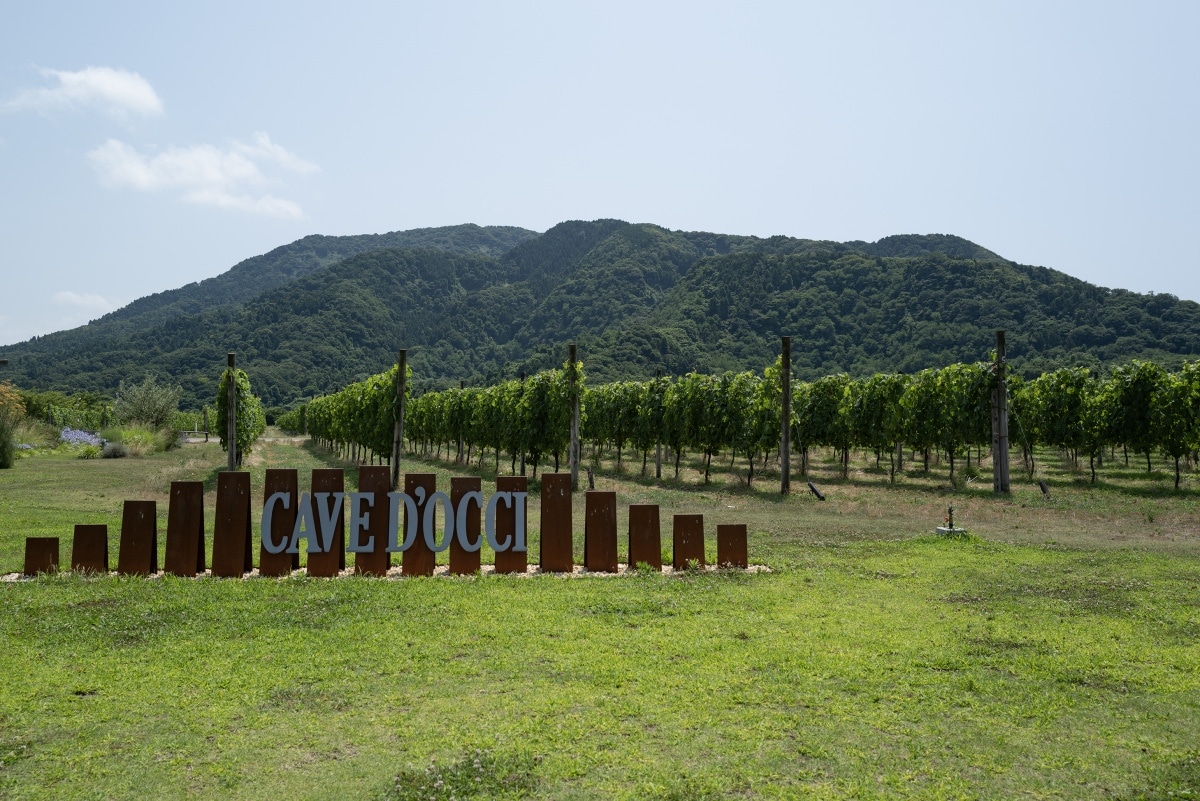
Cave D’Occi was founded in 1992 by winemaker Kiichiro Ochi and his business partner, Chieko Kakegawa (Fumito’s mother). Ochi had studied winemaking in Germany and visited wineries across Europe and the U.S. He was inspired by what he saw, especially the success of wine tourism in California’s Napa Valley. He returned to Japan with a bold vision: not to simply start one winery, but to create an entire wine region from scratch.
After an extensive search, he and Kakegawa found farmland near Niigata City that was perfect for their needs. Instead of rice paddies, there were fields of watermelon, tulips, and daikon surrounded by pine forests, with Mount Kakuda rising in the distance and not a house in sight. It reminded them of the Spanish countryside and had the perfect conditions for growing European grape varieties in Japan’s humid climate.
“We built the first building in what was pine forest, clearing just enough land for the winery and to create a small garden,” Fumito Kakegawa tells me. “We wanted people to have a reason to visit and drink wine here. But we needed a signature grape variety. Burgundy has Chardonnay and Pinot Noir. When you think of New Zealand, you think of Sauvignon Blanc.”
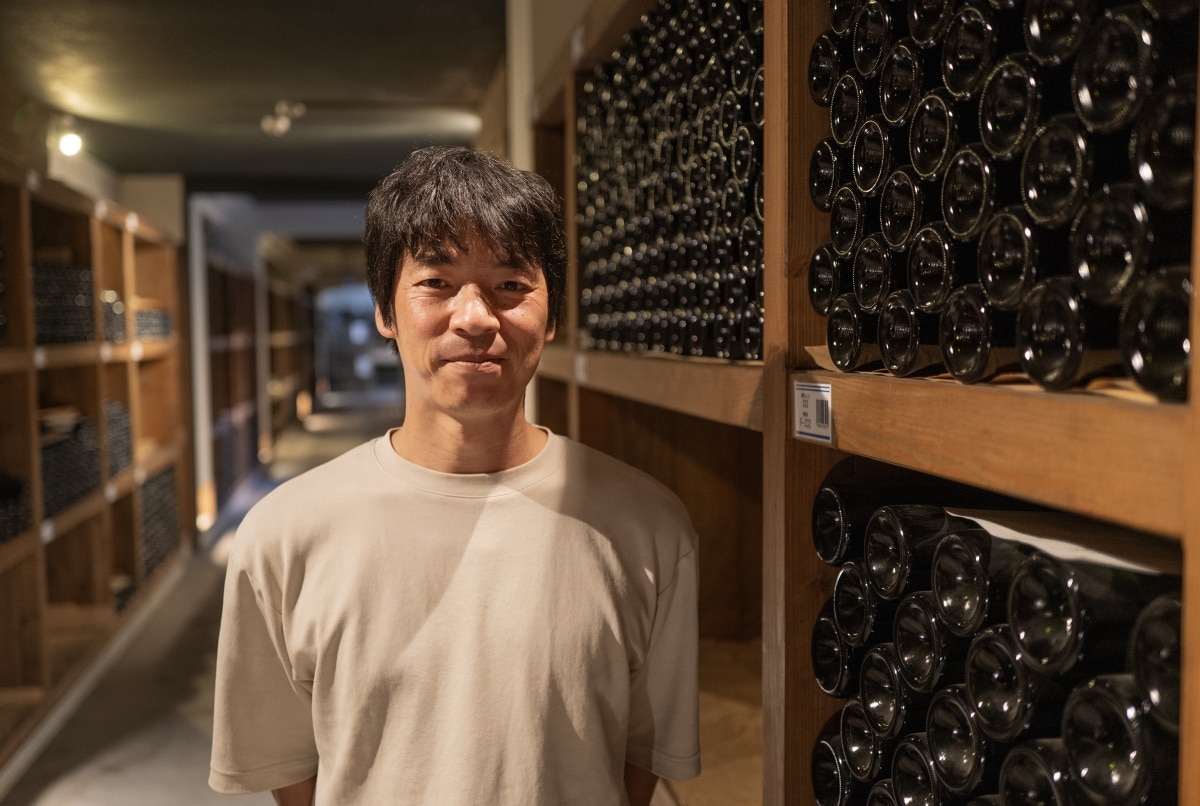
Winemaker Fumito Kakegawa in the cellar at Cave D'Occi winery in Niigata. Photo: Andrew Lee
Ochi was adamant from the beginning that he only wanted to make wine from European varieties grown domestically. This was something extremely rare at the time, as many Japanese wines labeled “Domestic Wine” were actually made locally from imported concentrate. Since 2018, new labeling laws require that “Japanese Wine” use 100 percent domestically grown grapes, while “Domestic Wine” must now list the country of origin.
For the first decade, Ochi and his team experimented. They planted Germanic varieties like Zweigelt, which proved unsuitable for Niigata’s hot summers, followed by dozens of other varieties, including Pinot Noir, Chardonnay, and Cabernet Sauvignon. While waiting for their own vines to bear fruit, they made wine onsite from grapes transported by ferry from Hokkaido. By the mid-1990s, the percentage of wine they produced from their own grapes was increasing—as were the number of visitors to the winery.
But a single winery does not a region make. Key to Ochi’s plan was cultivating satellite wineries that would share his philosophy and grow alongside Cave D’Occi. In 2003, he established a Winery Management School to attract people interested in starting a winery in the area.
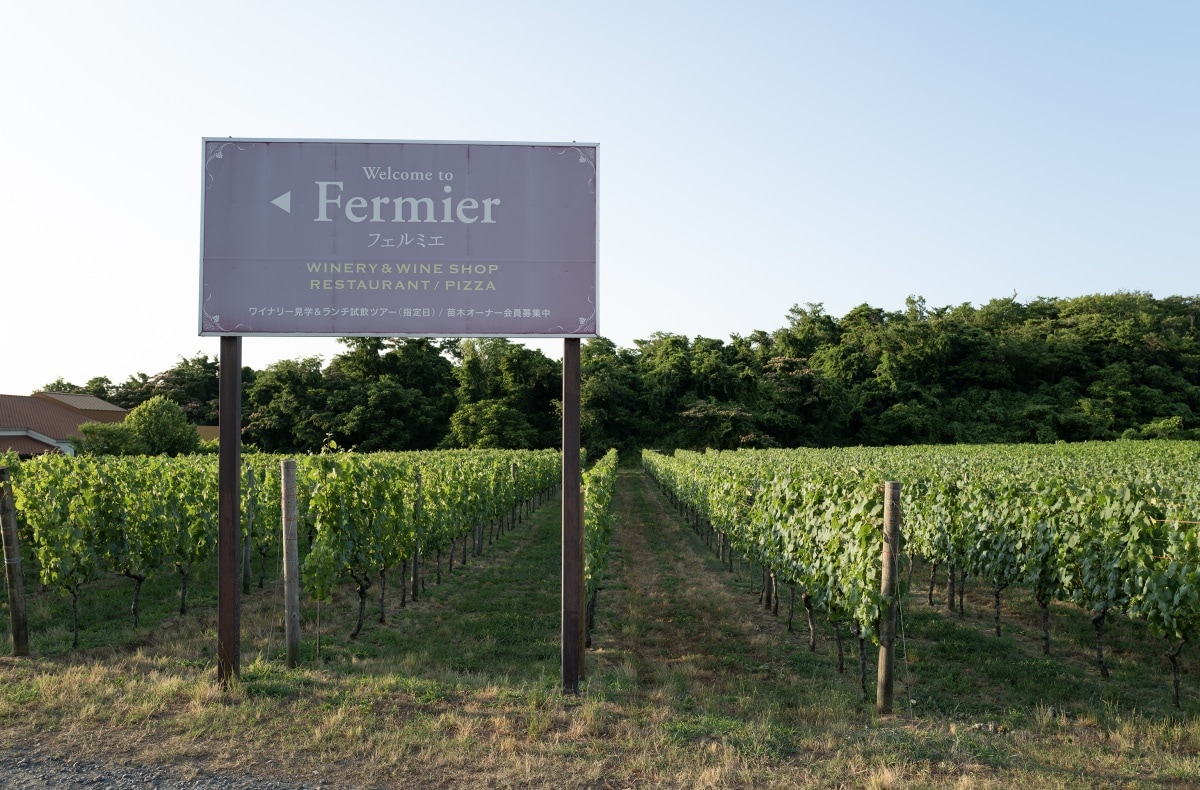
Fermier winery was started after former-banker Takeshi Honda graduated from Cave D'Occi's Winery Management School. Photo Andrew Lee
Back at Fermier, Honda tells me he was the first to make the move. “I was a banker in Tokyo,” he says. “I quit at 38, joined the school for six months in 2005, and started Fermier the next year. I genuinely love wine. I thought living life through wine must be the best job in the world.”
That morning, before meeting Honda, I had walked along a sandy trail beside the vineyards. The sun was still low, and the grapes ripening on the vine glowed a translucent green. I imagined how rewarding the coming harvest would feel and saw the attraction of leaving a corporate job behind to become a winemaker. Others felt that same pull, and there are now four wineries started by Cave D’Occi graduates, including Hakko Chaud, where I stopped on the way to Fermier.
Hideo Kobayashi trained alongside Honda at the management school and founded his winery (formerly Domaine Chaud) in 2009. He tells me he first became fascinated by wine while studying microbiology at university.
“Wine blew my mind compared to beer or sake, which takes so many steps to produce,” he says. “It's just grapes left to ferment, and I couldn’t understand how it was made. Even my professors couldn’t explain it.”
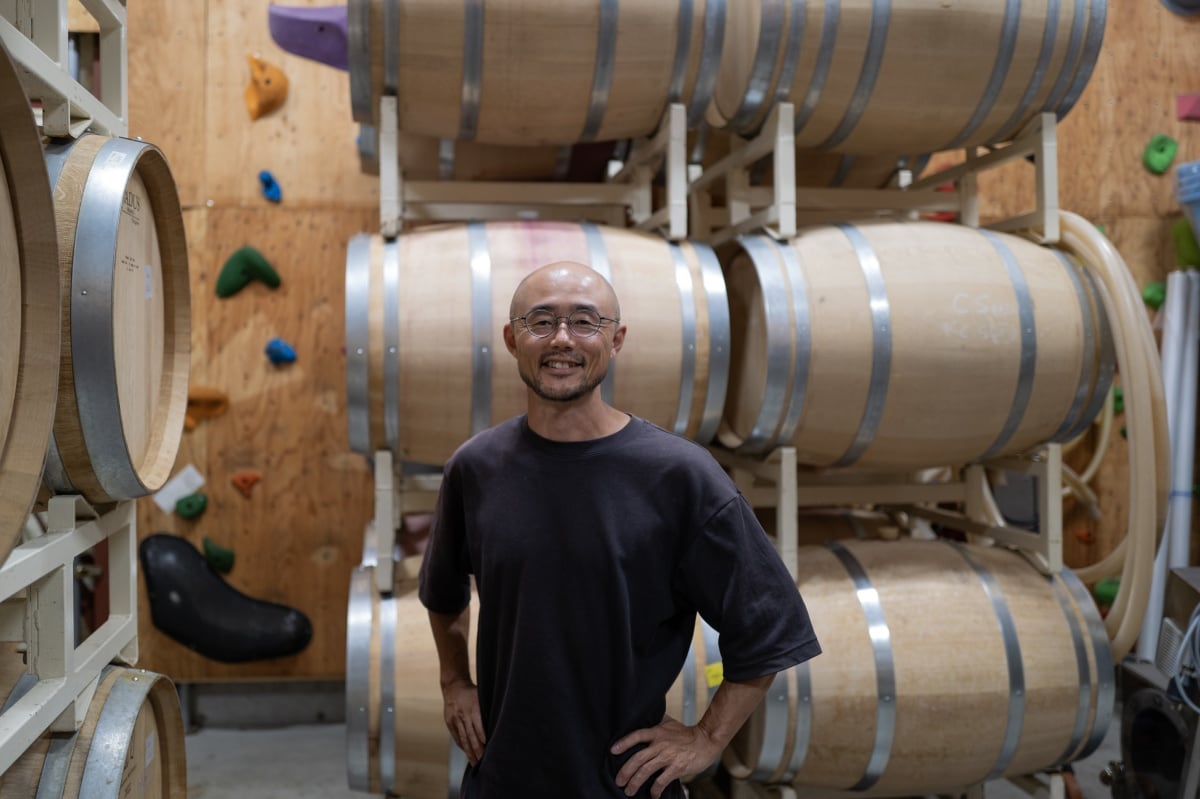
Winemaker Hideo Kobayashi started his winery Hakko Chaud (formerly Domaine Chaud) after studying at Cave D'Occi's Winery Management School. Photo: Andrew Lee
After finishing his PhD, he went to Australia to learn about wine firsthand and eventually ended up at Cave D’Occi—drawn by both the quality of their wine and their proximity to the sea.
“I need to live near the water,” he says, mentioning he goes diving at Sado Island, which is visible from the coast. “My father was a diver, and we went diving every weekend when I was young. So I ruled out starting a winery in Nagano, Yamanashi, or Hokkaido. And Okinawa is too hot for Pinot Noir. Then I discovered Cave D’Occi by the sea, tasted their wines, and thought they were amazing. When I met the owner he told me, ‘Just do it!’ So I did.”
Other graduates followed, including Kiyoshi Seto, who left a 26-year career in advertising to open Cantina Zio Setto in 2011, and Abe Takashi, a former IT executive whose Le Cinq opened in 2015. With five wineries operating, the area was officially named the Niigata Wine Coast.
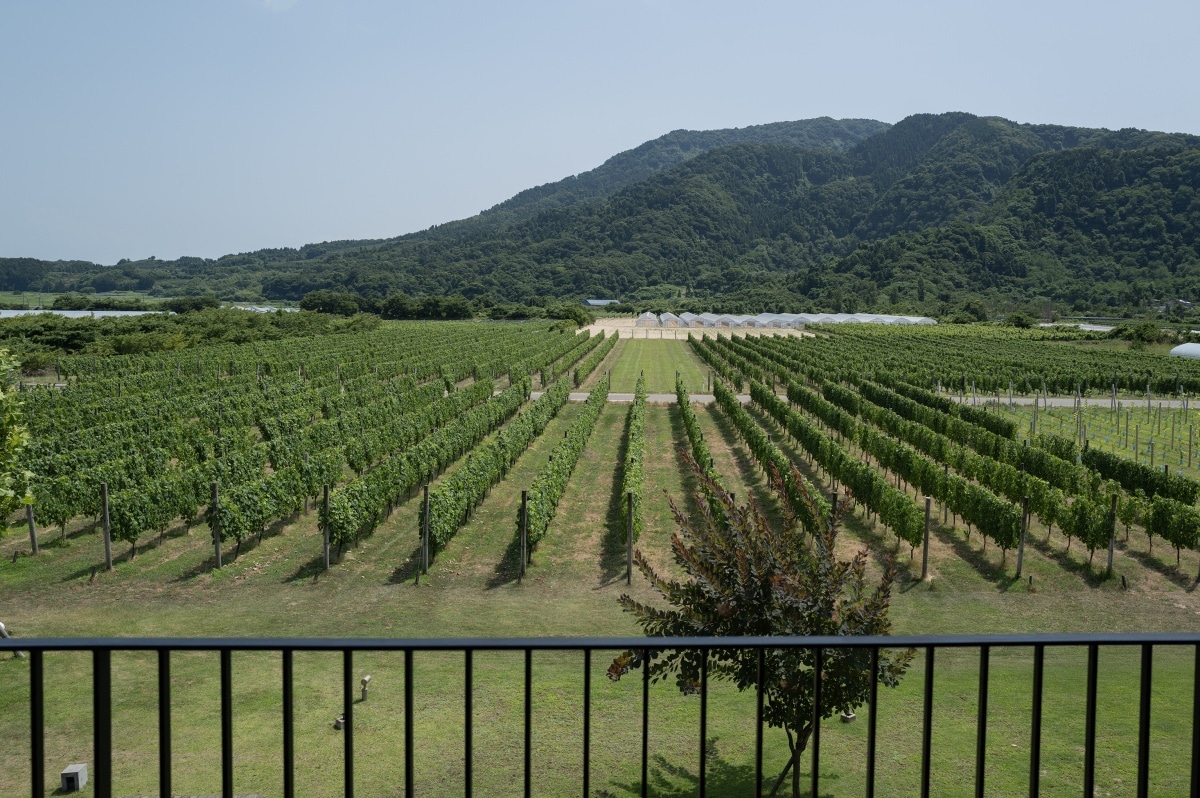
The view of the vineyards at the Niigata Wine Coast from Winerystay Travingne auberge hotel on the grounds of Cave D'Occi. Photo: Andrew Lee
To be blunt, Japanese wine regions generally aren’t beautiful—at least not in the romantic sense of Tuscany or Napa. Take Katsunuma in Yamanashi, Japan’s oldest winemaking area, where vineyards are scattered among houses and factories beside a freeway, power lines crisscrossing overhead. Its wines can be excellent, but the landscape lacks that classic wine-country feel. The Niigata Wine Coast, by contrast, was designed to look the part.
“Vineyards should be beautiful,” says Kakegawa. “That's very important.” This philosophy drove the region’s development from the start. “When the winery began, the atmosphere was wonderful,” he explains as we walk around his perfectly groomed vineyards. “People thought drinking wine in such a place was fun. But then they wanted food.”
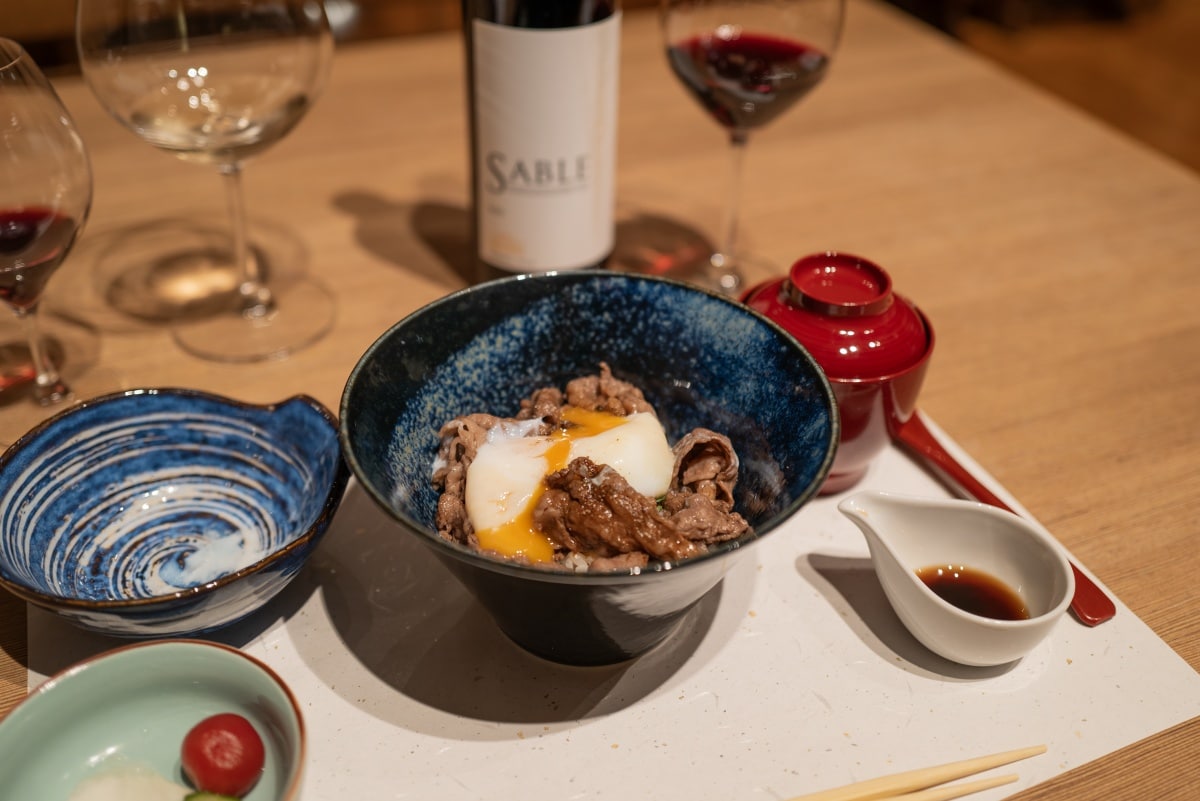
Kambara beef sirloin sukiyaki rice bowl with an onsen tamago at the Japanese restuarant at VineSpa hotel. Photo: Andrew Lee
So in 1995 they built a restaurant, which became so popular as a wedding venue it was booked out on weekends. They turned that space into an event hall and built a main dining room in 1999. A German-themed restaurant followed in 2002, along with beer and sausage production and a bakery cafe in 2003. By then, Cave D’Occi was a popular destination for day trips, and to improve the view, the founders even buried power lines at their own expense. But they were still missing that one signature grape.
The turning point came in 2005, when the founders tasted Albariño in a bar during a trip to the Atlantic coast of Spain. Noticing the geographic similarities between Rías Baixas and their little corner of Niigata, they decided to plant it—and it was a perfect match.
As the destination grew in popularity, so did the amenities. “Customers stopped coming during the long and cold Niigata winters, so we dug a hot spring and built a hotel,” Kakegawa says.
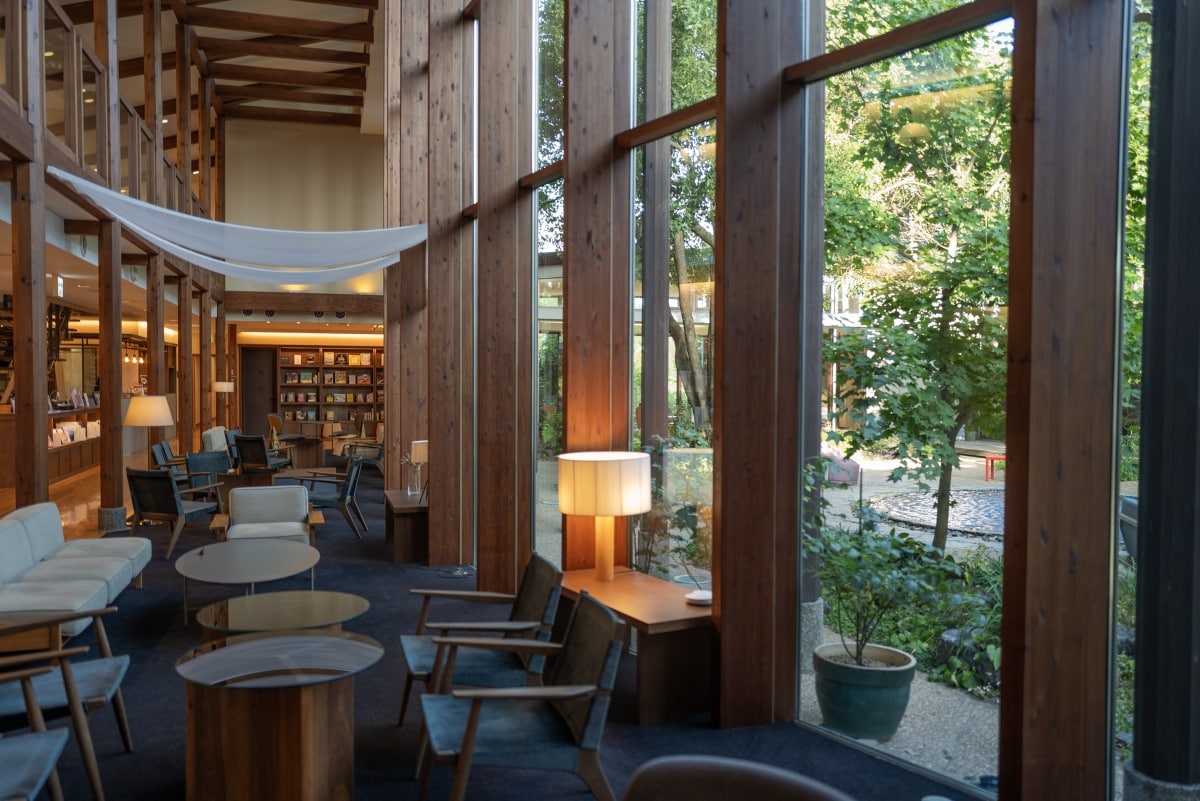
Book Cafe at VineSpa onsen hotel features over 1,000 books customers can browse while having a coffee or a glass of wine. Photo: Andrew Lee
VineSpa opened in 2009 with outdoor baths fed by geothermal waters from beneath Mount Kakuda. “Tasting only takes about 15 minutes, and dining about two hours,” Kakegawa says. “But with a soak in our onsen, it becomes six hours, or a full day with an overnight stay.” Fermier has embraced this model too, with a French restaurant at the winery that was featured in the Michelin Guide to Japan.
But the pinnacle of the area’s evolution into a destination for wine tourists is Travigne, a luxurious auberge hotel that offers fine dining and wine pairing. Opened in 2015, it was built in the style of a Spanish villa as a nod to Rías Baixas, and each of its ten guest rooms is styled differently, with opulent European furniture, high ceilings, and balconies that look out across the vineyards beneath Mount Kakuda. In the lobby is a grand staircase tiled with hand-painted tiles from Spain, and a lounge bar with a massive open fireplace. From inside, it is easy to forget that you are in Japan.
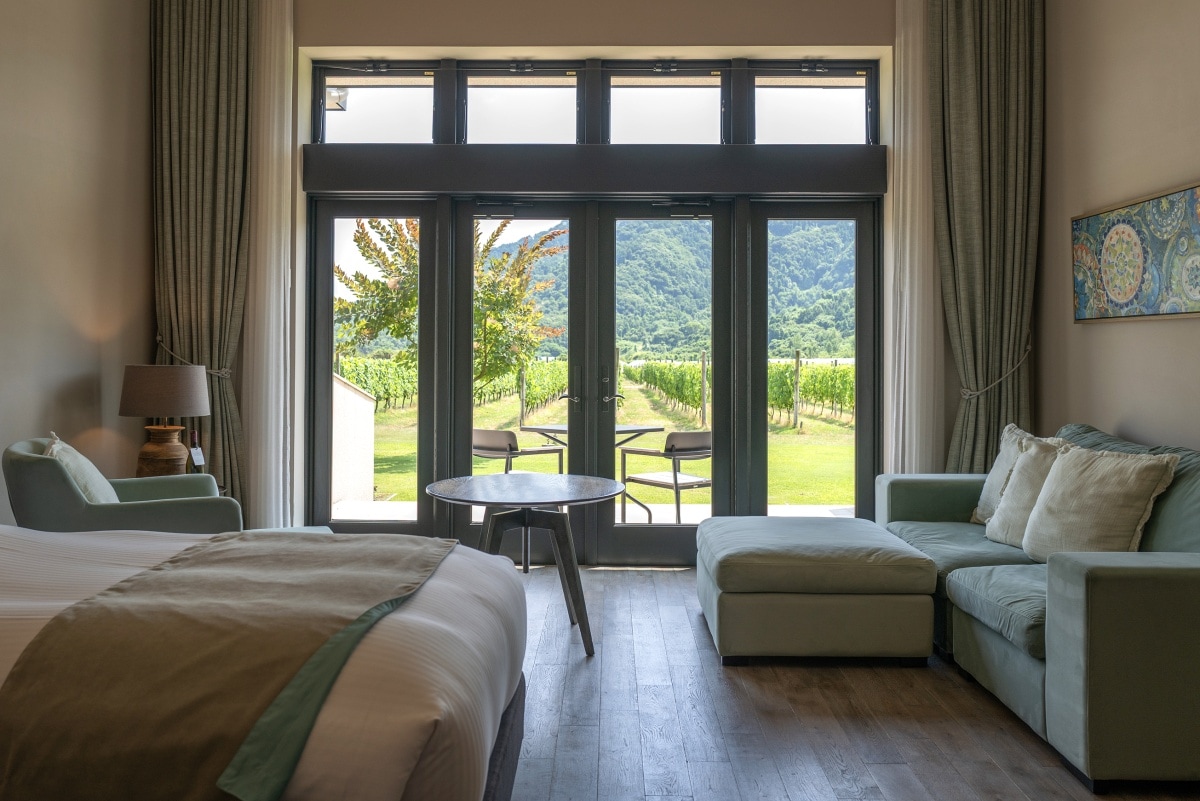
Each of the 10 rooms at Winerystay Travinge are styled with European furniture and look out over the vineyards. Photo: Andrew Lee
It’s inspiring to see what has been built here in just a few decades. As I finish one last glass of Albariño, I think back to something Kakegawa told me. “When we started, our wine may not have been especially delicious. But we needed people to buy it, or we couldn’t make wine the next year. We chose to spend time with our customers—talking about what we’re thinking, the future we envision, the dreams we have. Then customers drink and think, ‘It’s not great now, but it looks promising,’ and they buy it. They bought into a future that didn’t exist yet. That’s powerful.”
Getting there:
The Niigata Wine Coast is approximately 2.5 hours by train from Tokyo Station. Take the JR Joetsu Shinkansen to Niigata then transfer to the JR Echigo Line to Uchino. Cave D’Occi operates several free shuttle busses from Uchino Station daily. Visit https://www.docci.com/ for more information.


